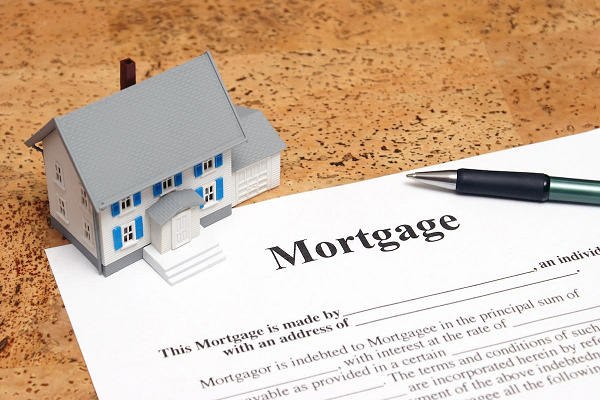What is the Difference Between a First and Second Charge Mortgage?
In order to understand how second-charge mortgages differ from first-charge mortgages, you need to consider the way home equity works.
For example, let’s say your home has a market value of £300,000 and you have £100,000 remaining on your original mortgage (your first-charge mortgage). You have built up £200,000 in equity in your home, i.e., the proportion of your home you own.
While continuing your monthly mortgage repayments as normal, you now have the option of taking out a second-charge mortgage (aka a second mortgage) against this equity. You may be able to borrow anything up to 85% LTV (loan to value) against your equity, meaning a maximum loan value of £170,000.
If you choose to do so, you will then have two mortgages secured against your home. Both require regular monthly repayments and carry the same risk of repossession if you fall into arrears.
What is the purpose of a second mortgage?
A second-charge mortgage can be a useful product for those who fall into the “asset-rich, cash-poor” bracket. Skyrocketing house prices have seen more UK homeowners than ever before become asset-rich over the past decade.
With the average UK house price now sitting at around £300,000, a second-charge mortgage can open the door to significant equity release at an affordable price.
Just a few of the most common reasons for taking out second mortgages include the following:
- Consolidating multiple debts to save money
- Funding for major home improvements and renovations
- Purchasing investment properties such as buy-to-let homes
- Helping family members get on the property ladder
- Buying cars and paying for holidays
- Funding new business start-up costs
With comparatively few restrictions, a second mortgage can be used for almost any legal purpose whatsoever.
What are the benefits of a second mortgage?
For those who are eligible for a second-charge mortgage, the main benefits are as follows:
- The potential to access a significant amount of money at a low rate of interest, repaid over a series of affordable monthly repayments
- A simpler and more cost-effective alternative to conventional equity release products with much greater flexibility
- There are no restrictions placed on how the funds are allocated, and there is the option of early repayment with some second mortgage products.
- Relaxed lending criteria, with loans available to applicants with poor credit and/or no formal proof of income.
Importantly, most second mortgage loans are bespoke financial products, tailored to meet the unique requirements of each applicant.
What are the drawbacks of a second mortgage?
On the downside, some of the potential disadvantages of second mortgage products are as follows:
- Interest rates vary significantly from one lender to the next, and additional costs may apply: arrangement fees, valuation fees, administration fees, broker fees, and so on.
- After taking out a second mortgage, you will have two mortgages secured against your home and will need to make two regular mortgage payments.
- Affordable second-charge mortgage products can be more difficult to access for those with poor credit, a history of bankruptcy, or self-employed status.
- If your home decreases in value and you are forced to sell it to repay your mortgages, the funds raised may not be sufficient to cover the full outstanding balance.
It is therefore essential to discuss all the potential pros and cons with your provider before applying for a secured loan.
How do you get a second mortgage?
Second-charge mortgages are available from a wide variety of major banks and specialist lenders. However, it is essential to apply exclusively to providers that are authorised and regulated by the Financial Conduct Authority (FCA).
The application process itself can be surprisingly straightforward, as the loan is technically issued against your equity, not the property itself. With all the essential paperwork and documentation in place, a second mortgage can be organised and accessed within a couple of weeks.
During this, you will be expected to provide evidence of your financial position, your employment status, your income level, any other major debts you are currently repaying, and so on.
Delays and disruptions may occur along the way, so it is advisable to get your application underway as soon as possible.
Mixed-Use Properties Enters Top Five Commercial Broker Searches, But What is a Mixed-Use Property?
Knowledge Bank’s latest round-up of commercial product search terms makes for interesting reading, as ‘mixed-use properties that are part commercial’ enters the top five for the first time since January. No movement was noted in the top three search terms for May, with semi-commercial ‘properties’, ‘maximum TV’, ‘maximum LTV’ and ‘minimum loan amount’ topping the table once again.
Meanwhile, there was no major movement whatsoever in the top three broker searchers within the bridging sector for May. Identical to April, the top searches for the month came out as regulated ‘bridging’, ‘minimum loan amount’, and maximum LTV’.
Over in the BTL arena, the top three search terms were ‘first-time landlords’, followed closely by ‘lending to limited companies’ requirement to be a homeowner’. All of them featured in the top five in April, having held their positions consistently for some time.
What is a mixed-use property?
New and established investors across the UK are increasingly setting their sights on mixed-use properties. By definition, a mixed-use property is a property that occupies two or more ‘use classes’ over different stories or areas of the structure.
For example, one of the most common mixed-use properties is a building that occupies one or more flats in its upper areas and a shop or commercial unit of some kind on the ground floor. Larger developments that comprise homes, offices, and commercial spaces in any number are also considered mixed-use properties.
The vast majority of mixed-use properties feature a vertical configuration, wherein residential units occupy certain floors and commercial/business units are based on other floors. There are exceptions to the rule where residential and commercial units may be configured horizontally, but this tends to be less commonplace.
What are the benefits of mixed-use properties?
From a resident’s perspective, living on a mixed-use property can be advantageous in many ways. Some people appreciate the proximity of their home to the amenities within the property, which could be anything from a supermarket to a gym to a bar or restaurant.
In addition, mixed-use properties are usually situated in fairly central locations and are likely to have excellent public transportation links. For those renting or buying commercial space in a mixed-use property, there is typically the benefit of high footfall in a busy urban centre.
From the investor’s viewpoint, mixed-use properties have the potential to combine the best of all worlds. Where an investor owns the property in its entirety, they can bring in potentially high rents from residential occupants and commercial tenants alike.
Savings can also be made on tax obligations, as buying a mixed-use property typically means paying stamp duty for the structure as a 100% commercial property. This can be cheaper than paying the equivalent stamp duty for a solely residential property, making for an attractive investment opportunity.
Specialist funding
Perhaps the only downside to mixed-use property investments is the lack of specialist products available on the High Street. A standard buy-to-let mortgage from a major lender cannot be used to buy a mixed-use property, and many lenders do not issue loans or mortgages for these kinds of properties at all.
Investors must therefore consider the options available away from the High Street’s biggest banks and lenders. The UK’s independent lending sector is typically a more accessible and cost-effective option for mixed-use property purchases, with a wide variety of options available.
Examples of these include bridging finance, specialist development finance, commercial buy-to-let loans, and other types of secured business loans.
For more information on any of the above or to discuss mixed-use property finance in more detail, contact a member of the team at UK Property Finance today.
How Much Does Development Finance Cost (and How is the Interest Paid)?
Development finance is a little more complex than a conventional mortgage, with funds that are issued in a series of stages. The lender appoints a surveyor to monitor the progress of the project, tying each loan instalment to the completion of key project phases.
First-charge (aka senior) development finance can be used to cover up to 85% of a project’s total costs. The rest can be covered with a second- or third-charge (mezzanine) product, enabling investors to cover up to 100% of a project’s costs with development finance.
Interest on a development finance loan accrues monthly, often at a rate of around 0.5% or less. But what are the total borrowing costs payable on development finance, and how are interest payments made?
How much does development finance cost?
Various factors influence the costs of development finance loans, including but not limited to the following:
- The track record and CV of the applicant.
- The nature and extent of the planned project.
- The location and value of the development.
- The sum of the loan required and its LTV.
- The projected final value of the development.
- The length of the loan repayment term.
As a general rule of thumb, development finance loans of £500,000 or more will typically have an interest rate of around 4% to 9% per year. Loans with a value of less than £500,000 are more likely to be charged at 9% to 12% per year.
However, interest rates are always negotiable, based on the factors above.
Additional borrowing costs incurred as part of a typical development finance product include the following:
- Lender arrangement fee: normally around 1-2% of the loan amount
- Lender exit fee: not always payable, but can be up to 1-2% of the loan amount.
- Valuation and monitoring of surveyor fees are variable by way of provider.
- Broker fees: brokers collect their commissions from the loan issuer and offer their services free of charge to the applicant.
Across the board, all borrowing costs can be minimised by enlisting the support of an experienced broker at an early stage.
How is the interest on a development finance loan paid?
Most development finance specialists are fairly flexible when it comes to interest payments.
There will usually be the option of repaying the interest on a monthly basis, leaving just the initial loan balance to repay when the facility matures. However, property developers often prefer the ‘rolled up’ interest option, where all interest owed is added to the final loan balance.
With the latter option, no monthly repayments at all need to be made during the life of the loan. This often suits the requirements and priorities of property developers looking to keep their own capital as liquid as possible.
Either way, prompt repayment holds the key to minimising the costs of development finance. Early repayment may be an option, but depending on the lender’s policies, it may result in early exit fees becoming payable.
Property Sales Down by Over a Third as House Prices Continue to Rise
Figures released by HMRC show house sales across the UK have seen a decline of more than one-third in March, when compared with March 2021.
Records show 11,650 home sales for residential properties took place in March, equating to a drop of 35.7% since March 2021. However, this also indicated a slight rise of 2.6% when compared with the previous month, February.
However, HMRC cautioned that these figures be treated cautiously due to the effect that the stamp duty holiday had on the property sales market, resulting in many people rushing out to buy before it was removed in September.
Initially, the stamp duty tax relief was scheduled to be finished in March 2021 but was later extended to June and then tapered to September 2021.
Managing director of Corecon, Andrew Montlake, commented: ‘The stamp duty holiday has distorted the data, so it was inevitable that transaction levels in March were down fairly significantly on the same month last year.’
‘To make matters worse, there is an extraordinary lack of stock. Transactions need buyers and sellers, and there is a distinct lack of the latter.
‘Moving forward, households face countless headwinds during 2022, primarily in the form of rising interest rates and soaring inflation, and these are likely to restrict transaction levels.
‘However, tenants remain desperate to get out of the rental market as rents hit new highs, and this will maintain a certain level of transactions. The ongoing rush to get out of the rental market may also explain why transaction levels in March were up in February.’
The chief executive of The Guild of Property Professionals, Iain McKenzie, commented that residential property sales continue to appear to ‘inhabit a parallel world when compared against all other economic indicators.’
He added, ‘Home moves are down year-on-year, but only because of a rush to buy in March last year caused by the impending end of the popular stamp duty holiday.
‘The industry continues to see a lack of properties on the market, which is pushing up prices across the board.
‘Demand remains high, and the market looks likely to keep moving upwards as it continues to ignore all the uncertainty in the rest of the economy.’
Jeremy Leaf, a north London estate agent and former RICS chairman, said: ‘Demand still comfortably exceeds supply, and correctly priced houses continue to attract considerable interest while mortgage repayments remain relatively affordable.’
Director of Legal & General Mortgage Club, Kevin Roberts, said: ‘Despite the pressure on borrowers caused by the rise in the cost of living, demand remains high, and the overall outlook for the market is strong. This is another clear reminder of the resilience of the current housing market and its ability to weather difficult conditions.
‘Even as the market experiences a healthy spring, the more complicated conditions mean that the role of advice is now more important. Borrowers may well need more support and reassurance to find the right mortgage for their needs. This is an opportunity for advisers to really demonstrate the scope of their expertise and add value during what will be a pivotal time for their clients.’
Last month, the Office of National Statistics revealed figures that show property prices have increased by 10.9% in the year to February, up from 10.2% in January.
February saw average house prices rise to £277,000, which indicates a £27,000 increase from the same period in 2021.
Bridging Loans Are the Buy to Let Investor’s New Top Choice
It’s not uncommon for buy-to-let investors to set their sights on properties in need of repairs and refurbishment. The reason being that, as competition for such properties is relatively low, they can often be picked up at rock-bottom prices. After which, the repairs and refurbishments can be performed at an equally low price before turning a profit on the property by letting it out to tenants.
Unfortunately, targeting properties in need of renovations or refurbishments can lead to problems with financing the purchase. This is because the vast majority of traditional lenders will only issue mortgages against properties that are considered habitable at the time of the application. Even if you can demonstrate your intention and capacity to renovate the property after the purchase, you’re unlikely to qualify for a traditional mortgage.
In addition, landlords often seek to expand their buy-to-let property portfolios by purchasing homes at auction. Some are in need of repair; others are perfectly habitable. In both instances, however, it is usually necessary to pay the full purchase price of the property (and any additional fees) within 28 days, sometimes sooner. Needless to say, this is nowhere near enough time to organise a traditional mortgage.
Combined with the increasingly restrictive lending criteria of major banks for buy-to-let landlords, all of the above places prospective investors in a tricky position.
A flexible and accessible alternative
This is precisely why bridging loans are fast becoming the new top choice for buy-to-let investors. A dynamic and flexible type of secured lending, bridging finance goes far beyond the limitations of traditional high-street mortgages.
For one thing, most bridging finance specialists are uninterested in the condition of the property. Even if it is in a pretty sorry state of repair, it has no real consequence for the lender. Instead, the only thing that matters is the borrower’s capacity to cover the loan with acceptable collateral. This may be provided in the form of the property being purchased or any other property currently owned by the applicant.
Likewise, bridging finance can be uniquely convenient and accessible for purchasing buy-to-let properties at auction. Irrespective of how much money is needed, it can typically be organised and transferred to the applicant within five working days. Again, it’s simply a case of the applicant putting up the necessary collateral to cover the loan. The nature and condition of the property being purchased are of no real interest to the lender.
What matters most with a bridging loan are two things: collateral and a viable exit strategy. By exit strategy, this means a clear and validated method of gaining access to the money needed to repay the loan on the agreed date. It’s possible to take out a bridging loan without an exit strategy, but this may, depending on the lender and the loan, result in higher overall borrowing costs.
Speaking of which, the potential value for money of a super-short-term bridging loan also appeals to buy-to-let investors. In many instances, it’s possible to borrow significant sums of money for less than 0.5% per month. Just as long as the loan is repaid quickly (in accordance with the agreement of the lender), overall borrowing costs can be kept to absolute minimums.
The importance of comparing the market
Now more than ever, the importance of comparing the market in full cannot be overstated. Particularly when considering buy-to-let investment opportunities, it is essential to consider as many deals as possible from as many lenders as possible.
The quickest and easiest way is to take your case to an independent broker, who can compare deals from a panel of specialist lenders on your behalf.
5 Ways to Resell Any House Quickly
Pricing a property can be difficult, especially if you are in the business of reselling. This is when you purchase a low-priced property and try to sell it for a profit. There are several ways to do it, and this tried and tested method will show you how.
Find your price
The very first thing that you need to do is find out what your property is going to sell for on the retail market. The best way to do that is to do a search of all the comparable homes that have sold recently within a quarter of a mile from your property. The highest average price they have sold for is the retail price. As soon as you find out what the retail price is, you need to choose what your exit strategy is going to be.
Wholesale strategy
If you are going to wholesale your property, it’s very simple. You list the property at 50% off the retail price. If you are going to wholesale to another investor, you have to leave enough room for them to make money as well, so the right percentage to entice them in is 50% off retail. If you were going to do it on an example property that retailed at £100,000, it would be good to list it at £49,900.
Prehab strategy
Now, if you are going to prehab your property, which means you are going to do a very light prehab to make it rental-ready for the buyer, not a full prehab, you are going to be pricing it at 10 to 15% off retail value. In the example house above, the retail price is £100,000. So, if you are going to prehabit it and put £8,000 or less into improving it, you need to price it 10 to 15% off of that retail price. A good figure would be £84,900.
Retail strategy
Next, if you’re going to be listing your property and selling it at retail, this is the formula that you are going to use. Clearly, you already know what the other properties are selling for. However, what you should always do if you don’t want it to sit on the market is price it at 95% of its retail value. You can price it as high as 100% or even more, but the higher you price it, the longer it’s going to sit on the market. So, 95% of the value is a great price at £94,900.
Attractive pricing
On the example property, let’s imagine we decided to prehabit it. Whenever you’re pricing a property, the other thing you need to look at is pricing it attractively. Going with this formula, you could very easily price it at £85,000 or £90,000, but those are not very attractive prices. The attractive price is £84,900 because it sounds a lot cheaper, even though you have only knocked £100 off.
8 Questions To Ask Prior To Buying Land
Buying a piece of land is one of the most critical aspects of building. It is the place that your dream home will rest upon for a lifetime; therefore, it is important to absorb as much knowledge as possible before you ever put a deposit on a piece of land for sale.
Are your dreams realistic, and what is the eventual return? Consider the surroundings, the community, and whether the land is wet or dry. What does the adjacent property look like, or who are your neighbours? Is the land worth the money you will be spending to purchase a parcel? How many acres is the land, and does the piece of land provide the adequate space you need to hold your dream home’s building design?
Here are 8 questions you should get answered before buying a piece of land:
- Does the surrounding area have quick exit points to major highways? This may not seem like a big deal, but in case of natural disasters or even for the convenience of getting from one place to another in a hurry, major highways are essential to the land you want to live on.
- What is the area going to be like in 10 years? Does it have sustainable infrastructure, or is the community destined to struggle with time? No one can be a fortune-teller, but you should study the history of the area for any revealing tell-tale signs that may determine the worth of your property further down the line. If recent malls and housing developments have been springing up nearby, that’s a good sign of growth.
- Anyone who is considering buying land needs to look at the overall value of the land and compare it with all the options. Look for intangibles, like wide open areas or land that can be used for farming, industry, or even other real estate opportunities.
- How accessible is the land you’re going to buy? For example, if you live too far out in the woods, it could cost you a pretty penny to hire builders who will charge for extra travel and materials. It could also cost more for heat, snow removal, road improvements, etc. It may not be a good thing if the land is too isolated.
- If at all possible, try to rent property in the area before you buy the land. Doing this will allow you to get to know the community and see if it’s really somewhere you want to live.
- Another good idea when considering buying land is to look at the zoning requirements. Look for any potential problems with the building plans you may have in the future. You don’t want to buy land somewhere only to discover there may be limitations on your home building plans, or perhaps you would not be allowed to set up a business on your land because of zoning restrictions. Find out now before you buy land!
- You should also look into any potentially hidden industries in the surrounding area that could come as a surprise later on. You don’t want to buy a piece of land and find out there is a big nuclear power plant or factory nearby that sends its foul air or poisonous gases your way.
- Research the parcel’s background to see if it has a hidden history, such as hazardous waste accidents, ghost stories, or any other weird circumstances. Make sure it has a clean title as well.
After you find out the answers to these 8 considerations in buying a plot of land, you will feel more peace of mind that the land you are buying is a good choice. It will also be less stressful; otherwise, you could run into a lot of problems when building a home on your new land. Clean land has the potential to become an investment for you in the future. Never assume anything in the real estate business. Any extra information that you can find will go a long way in your search!
8 Amazing Modern Eco Construction Technologies
The days when eco-friendliness was the sole preserve of individuals are firmly in the past. Today, more commercial applications of eco-friendly technologies are in use, especially in the construction niche.
This piece takes a look at some of those that have caught the eye in recent times:
- Cool roofs: In construction, cool roofs are used to increase solar reflectance while reducing thermal emissions. The first benefit of cool roofing is that it lowers the temperature of the property. The second benefit is that it lowers the temperature inside the building after construction. It achieves this by trapping the air inside and reflecting intense heat from the outside. This process reduces the strain placed on cooling systems, leading to a reduction in emissions and, as a result, cooling and heating properties.
- Solar roof tiles: Solar roof tiles are becoming more popular with large-scale property construction and new building developments. The tiles, or shingles, as they are known in some quarters, are made of photovoltaic sheets laid on top of existing shingles. They work like the typical solar panel installation, but without the bulky and top-heavy appearance. Solar roof tiles used in construction today have a sleek and perfectly blended appearance.
- LED lighting: LED lighting technology is one of the main breakthroughs in the quest for eco-friendliness. Large-scale commercial properties finished today now consume up to 95% less energy when compared to incandescent lighting and up to 30% less energy when compared to fluorescent lighting. On a commercial property, the energy savings can be enormous.
- Insulation: The insulation sector offers perhaps some of the best examples of eco-friendliness. More construction companies are using recycled materials for insulation. Cotton insulation is a major example, and it involves the use of recycled denim to keep properties insulated. Cellulose insulation is second on the popularity stake, but again, it requires the use of recycled paper sprayed into the walls of properties. Like cool roofs, properly insulated properties reduce energy used in heating and cooling.
- Rammed Earth: Rammed earth construction involves using natural raw materials to create sturdy buildings. The process involves mixing substances like clay or gravel and combining them with stabilising elements such as concrete. The mix is compressed, and the result is solid, hard walls. The formation is allowed to “cure and harden” for up to two years. The density of the material means it is perfect for temperature-regulated building construction. The resulting structures stay warm in winter and cool in summer. Additionally, rammed earth construction generates fewer emissions than standard building processes.
- Geothermal heating: Geothermal heating is another efficient source of renewable energy. The earth’s natural energy is tapped to produce power. It is used in construction to create environmentally friendly structures that will not rely on natural gas or coal-powered electricity. Geothermal heating is highly efficient, even during the winter. The pipes that are the foundation of the process are buried underground, away from the effects of freezing temperatures. During freezing temperatures, the ground level at which the pipes are buried still posts temperatures of 15.5 degrees Celsius. This means that geothermal heating can remain a reliable source of energy year-round.
- Zero energy constructions: Zero-net-energy buildings, as they are equally known, are designed to function away from the central electricity grid. Many renewable energy processes are incorporated and amalgamated to ensure the buildings can generate power. Such buildings do not only produce energy. They also emit zero carbon emissions as a result of their reliance on renewable energy supplies. The zero-energy construction drive is most visible in small communities where homes can combine renewable resources. However, this construction technology is quickly gaining prominence in city centres and commercial hubs.
- Hempcrete: In some parts of the world, hemp is used in construction, during the installation process, and as insulation. Hempcrete is a mixture of hemp and lime that is similar to concrete. The technology has not been fully tapped into as a result of legislation against hemp in different parts of the globe. However, the technology is impressive nonetheless.
These are exciting eco-construction technologies that are in use today. It remains to be seen how fast these technologies will be adopted in more places across the globe, especially outside the West.




 0116 402 7982
0116 402 7982







